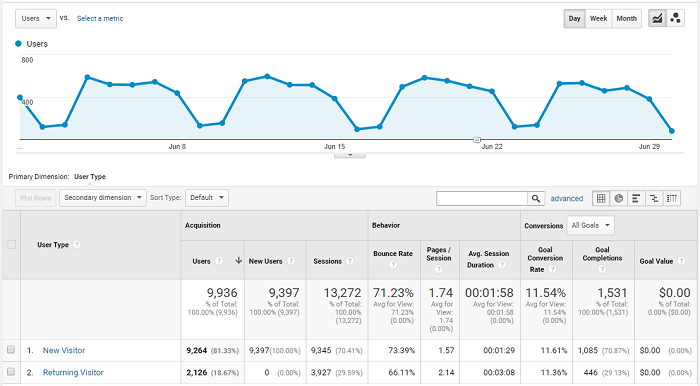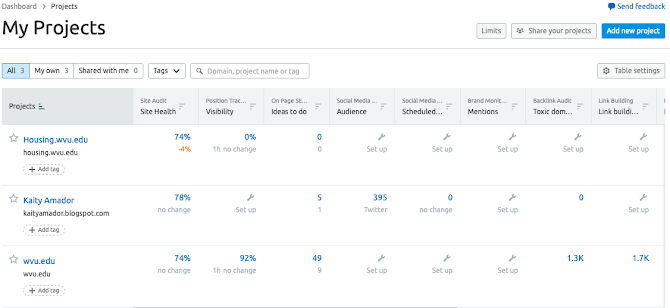Returning Visitors May Be Your Most Undervalued Metric
Is your website building loyal customers effectively?
Are you keeping track of your website's returning visitors? If not you may want to start now.
Returning Visitors Defined
Returning visitors can be an indicator that your website is effectively targeting the right audience and is successfully engaging it’s visitors. Returning visitors as a metric, falls into the KPI category, visitor characterization and indicates the “number of unique visitors with activity consisting of a visit to a site during a reporting period and where the unique visitor also visited the site prior to the reporting period.” (Week 1 Lesson: Key Terms, 2021). When using Google Analytics, a returning visitor is anyone who has visited the same site within the past two years and returns to it from the same device (Google Analytics Made Easy, 2020). Everyone who visits a website generates a unique random number and timestamp that combine to create a Client ID. This Client ID allows a visitor to be tracked and this is how returning visitors are captured. It is important to note that if one person is logging onto a site from a different device (phone, laptop, tablet, etc.) each counts as a new visitor. This may result in some inaccuracies when viewing new versus returning customers, but overall, this metric is still important to track.

New vs. Returning Visitors in Google Analytics (Analytics Edge, 2020).
Why is this Metric Important?
Many businesses and brands often forget that returning visitors are easier to receive conversions from than first time visitors, which is why this metric is so important. Returning visitors can also tell you how successful marketing campaigns are, who are loyal customers or audiences and how powerful you brand, or website is (Akhtar, 2020). A study conducted by Barilliance revealed that returning visitors added items to their carts 65.16% more than first time visitors, converted 73.72% more than first time visitors and spent 16.15% more per transaction (Serrano, 2018). Alongside this, Harvard Business Review found that marketers focusing their efforts on returning customers can see an ROI of up to 15x, versus traditional acquisition campaigns who see ROI of 4-6x (Cheng, 2015). Here we can see that returning visitors drive revenue and can lead to customer loyalty, increased conversions and higher engagement.
How Do I Retain Visitors?
There are various marketing tactics ecommerce sites and sites in general can employ to retain customers and visitors.
1. Abandoned Cart Messages
· For ecommerce sites, abandoned cart messages are a great way to ensure your customers come back and purchase what is in their cart. Contacting customers via e-mail and giving them exclusive offers can entice them to make that cart purchase, and drive customer retention.
2. Newsletter Sign-Ups
· If a visitor comes to you bog or website, make sur they come back by prompting them to sign-up for e-mail notifications/newsletter from your site. This can remind a visitor about your content, and be the first step into building a loyal visitor.
3. Create scannable content
· Web users spend an average of 5.59 seconds looking at a site’s content, so you have to make sure they are reading the most important content quickly to engage them (Balkhi, 2018). You can do this by making sure your website is easy to read, content is broken up with graphics and videos, there are subheading that will help users find specific content easily and use bulleted lists to keep info. short and sweet.
Returning Visitor Rate
Returning visitor rates measures the rate of return visitors to your website in any given time period. This can be calculated by dividing the number of return visitors by the total number of unique visitors over a given period of time. For example, if you had 1000 visitors in 1 month, and 500 repeat visitors in that same month, your equation would be 500/1000 = .5, giving you a RVR of 50% (Cheng, 2015).
References
Akhtar, A. (2020, November 19). 7 Proven Ways to Increase Your Returning Visitor Rate. MonsterInsights. https://www.monsterinsights.com/proven-ways-to-increase-your-returning-visitor-rate/
Balkhi, S. (2019, November 5). 7 Ways to Keep Visitors Viewing Your Website Longer. Keap. https://keap.com/business-success-blog/marketing/content-marketing/7-ways-to-keep-visitors-on-your-website-longer
Cheng, R. (2017, February 2). How Loyal Are Your Customers? This Metric Has the Answer. Contently. https://contently.com/2015/08/18/how-loyal-are-your-customers-this-metric-has-the-answer/
Serrano, S. (2018, March 7). Get Customers to Return and Doubles Sales (learn how you can start). Barilliance. https://www.barilliance.com/new-vs-returning/

Hi Kaity,
ReplyDeleteReturning visitors is not a metric that I have not thought much about. It makes sense to target returning visitors. They already know the brand, so they are easier to convert than new ones. We tend to want to focus on attracting new customers to grow brand awareness and increase revenue, but new customers are more expensive to attract than ones a business already has. We shouldn't forget returning visitors in favor of new ones. I definitely will not forget to track returning visitors in the future.
Hi Kaity,
ReplyDeleteI'm glad you point out how Google classifies returning visitors as someone who "returns to it from the same device" as I believe this aspect of returning visitors can be very confusing. For example, say I'm at work and I come across a thought leadership post on LinkedIn, then click through to the article on a business' website. I'm now in the "brand awareness" phase of a customer journey. I read the article, am impressed by their insights, and make a mental note to return someday. Google Analytics captures me as a new visitor. Then a few weeks later, I am tasked by our agency to solve a particular issue, and that thought leadership piece comes to mind. Now however, I'm in the "consideration" or "education" phase of my customer journey. I take out my phone (because I'm on the road) and look up that site. I fill out an inquiry form and convert to a lead. However, even though I'm technically a returning visitor, Google Analytics would not classify me as such since I'm now on my mobile device. How confusing for marketing analysis! I believe Google should have some kind of mechanism, or tag, or filter in place to at least allow us to understand these behaviors for more accurate analysis.
You would be surprised what Google knows. That is one of the reasons they are walking away from cookies and going to User ID. They have a better understanding of how you work than you might think...which, in and of itself, is somewhat scary...
DeleteReturning visitors, especially loyalists and advocates, are important. You need new visitors but taking care of returning visitors is the key. Returning visitors, especially loyal ones, often have different interests than customers who show up less frequently. These returning visitors should be nurtured and if you can find a way to engage, you should.
ReplyDelete